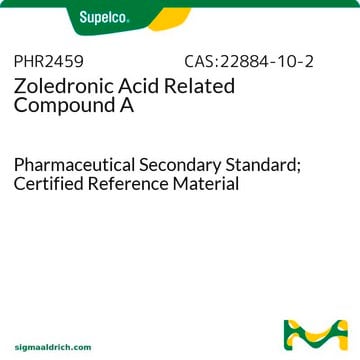SML0223
Zoledronic acid monohydrate
≥98% (HPLC)
Synonym(s):
P,P′-[1-Hydroxy-2-(1H-imidazol-1-yl)ethylidene]bisphosphonic acid monohydrate, Zoledronate monohydrate, [1-hydroxy-2-(1H-imidazol-1-yl)ethane-1,1-diyl]bis(phosphonic acid) monohydrate
About This Item
Recommended Products
Assay
≥98% (HPLC)
form
powder
storage condition
desiccated
protect from light
color
white to beige
solubility
H2O: ≥2 mg/mL
storage temp.
2-8°C
SMILES string
O.OC(Cn1ccnc1)(P(O)(O)=O)P(O)(O)=O
InChI
1S/C5H10N2O7P2.H2O/c8-5(15(9,10)11,16(12,13)14)3-7-2-1-6-4-7;/h1-2,4,8H,3H2,(H2,9,10,11)(H2,12,13,14);1H2
InChI key
FUXFIVRTGHOMSO-UHFFFAOYSA-N
Looking for similar products? Visit Product Comparison Guide
Application
- as an inhibitor for cell proliferation in glioblastoma, breast cancer tumor and prostate cancer cell line LAPC4
- as a conjugate with D,L-lactide 75: glycolide 25 (PLGA) to analyze its bone formation functionality in distal femur
- as an inhibitor for farnesyl diphosphate synthase enzyme in glioblastoma cells
Biochem/physiol Actions
Preparation Note
Signal Word
Warning
Hazard Statements
Precautionary Statements
Hazard Classifications
Eye Irrit. 2 - Skin Irrit. 2 - STOT SE 3
Target Organs
Respiratory system
Storage Class Code
11 - Combustible Solids
WGK
WGK 3
Flash Point(F)
Not applicable
Flash Point(C)
Not applicable
Certificates of Analysis (COA)
Search for Certificates of Analysis (COA) by entering the products Lot/Batch Number. Lot and Batch Numbers can be found on a product’s label following the words ‘Lot’ or ‘Batch’.
Already Own This Product?
Find documentation for the products that you have recently purchased in the Document Library.
Customers Also Viewed
Articles
Discover Bioactive Small Molecules for Lipid Signaling Research
Discover Bioactive Small Molecules for Lipid Signaling Research
Discover Bioactive Small Molecules for Lipid Signaling Research
Discover Bioactive Small Molecules for Lipid Signaling Research
Our team of scientists has experience in all areas of research including Life Science, Material Science, Chemical Synthesis, Chromatography, Analytical and many others.
Contact Technical Service












